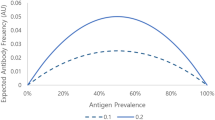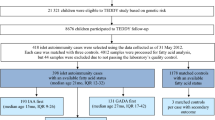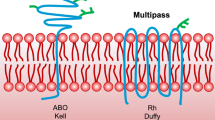Abstract
THE human A and B antigens on fœtal red cells are weaker than those on erythrocytes of adults and undergo marked quantitative changes during life. Reports describing these changes appeared in the literature as early as 1929. Morville1 stated that in most instances the A and B antigens seemed to have reached maximal strength by the time the child was four months of age. However, according to Thomsen and Kettel2, the strength of the antigens increased more slowly, and maximal values were not reached until 15–20 years of age, afterwards remaining constant. This view was challenged by Lodenkämper and Stienen3, who provided data indicating that the A and B antigens reach maximal strength at one or two years of age and remain at this level to 30–40 years of age; thereafter the strength of the antigens decreases and approaches zero. Obviously, these reports disagree with respect to the age at which the A and B antigens reach adult strength, and they also disagree as to the strength of these antigens in old age.
This is a preview of subscription content, access via your institution
Access options
Subscribe to this journal
Receive 51 print issues and online access
$199.00 per year
only $3.90 per issue
Buy this article
- Purchase on Springer Link
- Instant access to full article PDF
Prices may be subject to local taxes which are calculated during checkout
Similar content being viewed by others
References
Morville, P., Acta Path. Microb. Scand., 6, 39 (1929).
Thomsen, O., and Kettel, K., Z. Immun.-Forsch., 63, 67 (1929).
Lodenkämper, H., and Stienen, G., Aerzt. Wschr., 8, 110 (1953).
Grundbacher, F. J., J. Immunol., 93 (in the press).
Mollison, P. L., Blood Transfusion in Clinical Medicine, third ed. (Black-well, Oxford, 1961).
Race, R. R., and Sanger, Ruth, Blood Groups in Man, fourth ed. (Black-well, Oxford, 1962).
Ikin, E. W., Lehmann, H., and Mourant, A. E., Brit. Med. J., ii, 602 (1953).
Sachtleben, P., Lehmann, H., and Ruhenstroh-Bauer, G., Blut, 7, 369 (1961).
Grundbacher, F. J., Pediatrics (in the press).
Knoll, W., in Handbuch der gesamten Hämatologie, edit. by Heilmeyer, L., and Hittmair, A., 1 (Urban and Schwarzenberg, Berlin, 1957).
Stormont, C., Proc. U.S. Nat. Acad. Sci., 35, 232 (1949).
Vogel, F., Pettenkofer, H. J., and Helmbold, W., Acta Genet. Stat. Med., 10, 267 (1960).
Wiener, A. S., and Moor-Jankowski, J., Science, 142, 67 (1963).
Author information
Authors and Affiliations
Rights and permissions
About this article
Cite this article
GRUNDBACHER, F. Changes in the Human A Antigen of Erythrocytes with the Individual's Age. Nature 204, 192–194 (1964). https://doi.org/10.1038/204192a0
Issue Date:
DOI: https://doi.org/10.1038/204192a0
This article is cited by
-
ABO Blutgruppenantigene im Stroma erkrankter Hornhäute
Spektrum der Augenheilkunde (1998)
Comments
By submitting a comment you agree to abide by our Terms and Community Guidelines. If you find something abusive or that does not comply with our terms or guidelines please flag it as inappropriate.



